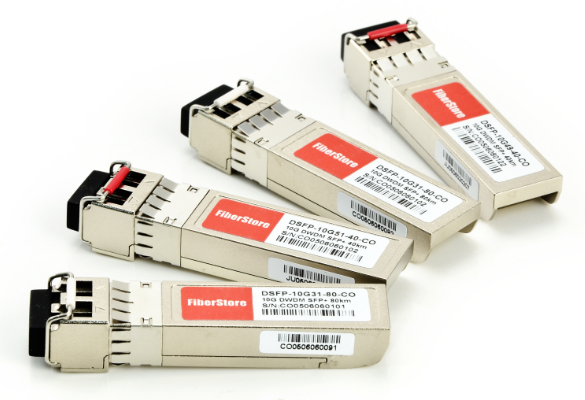To keep pace with the rapidly growing volumes of data-network traffic driven by the growth of the Internet, service providers are always looking to increase the fiber capacity and wavelength spectral efficiency in their networks. DWDW (dense wavelength division multiplexing) is an optical multiplexing technology used to increase bandwidth over existing fiber networks. DWDM works by combining and transmitting multiple signals simultaneously at different wavelengths on the same fiber. It has revolutionized the transmission of information over long distances. DWDM can be divided into passive DWDM and active DWDM which will be illustrated in this article.
“Passive” refers to the passive DWDM MUX DEMUX element which is an unpowered, pure optical equipment. Passive DWDM systems have no active components, which means that no optical signal amplifiers and dispersion compensation modules (DCM) are used. The DWDM passive link is only determined by the optical budget of transceivers used. Passive DWDM system has a high channel capacity and potential for expansion, but the transmission distance is limited to the optical transceivers used. The main application of passive DWDM system is metro networks and high speed communication lines with a high channel capacity.

Active DWDM system is built from transponders, providing full optical demarcation point agnostic to the routers, switches and ADMs within the network. Active DWDM offers a way to transport large amounts of data between sites in a data center interconnect setting. The transponder takes the outputs of the SAN or IP switch format, usually in a short wave 850nm or long wave 1310nm format, and converts them through an optical-electrical-optical (OEO) DWDM conversion. In long-haul DWDM networks, several EDFAs are installed sequentially in the line. The number of amplifiers in one section is determined by the fiber cable type, channel count, data transmission rate of each channel, and permissible OSNR value.

Besides, the maximum transmission distance of the active DWDM system also depends on the influence of chromatic dispersion—the distortion of transmitted signal impulses. When designing a DWDM network project, permissible values of chromatic dispersion for the transceivers should be considered, and, if necessary, chromatic dispersion compensation modules are included in the line. DCM fixes the form of optical signals that are deformed by chromatic dispersion and compensates for chromatic dispersion in fibers.
Choosing passive or active DWDM system depends on your requirements and current setup. Because both of them have pros and cons.
Passive DWDM Pros: 1. Inexpensive - As mentioned above, less components are required, and less engineering time is required.
2. INITIAL Setup - Because of the colored optics there isn't a need to tune wavelengths for all of your connections. It's a matter of matching your colored optics and plugging it.
Cons: 1. Scalability - you are limited to colored optics, and less wavelengths on the transport fiber. As you grow, you would be required to have more passive devices. Furthermore, with the more passive devices, you have more difficulty to manage. And you will have to start managing the same wavelength on multiple passive devices and they could be serving different purposes on each depending on your setup.
2. Control - If you need to change a wavelength or connection for whatever reason, your option is limited to taking it out of service and disconnecting the physical cabling as the wavelength is tied to the optic.
Active DWDMPros:
1. Active can fit a lot more wavelengths (colors) onto a single fiber pair. The composite signal that is sent over a single fiber pair can carry more bandwidth than a passive of the same size, in turn you don't need as much physical fiber between your two sites (this really only applies if you require that much bandwidth). This is advantageous when distance is a problem because it allows you to get more out of a single leased fiber pair as opposed to passive.
2. Active setups grant you more control over your optical network, you can dynamically re-tune wavelengths without dropping connections (it's transparent to whatever is riding on that wavelength).
3. Scalability - Active can be easier to scale as your network grows (you can fit more wavelengths on the fiber, see above), but again - we're talking seriously big iron. I'll dig into it a bit more below.
Cons: 1. EXPENSIVE - Active DWDM setups are much more expensive compared to passive DWDM. If you don’t have long-distance requirements, don’t choose active DWDM.
2. Configuration - Depending on your vendor, configuration can be a serious undertaking, and require a solid understanding of optical networks. There are many more components in active builds.
Most of the time, DWDM operates with powered component like transponders. Further, after multiplexing the signals, they typically need active amplification to have any preferred reach. Without this, you're only going with a relatively short distance, which is not a good value for the expense of DWDM.













